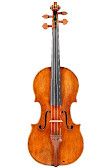Santo (Sanctus) Serafin
1699–1776Santo Serafin was born in Udine and lived in Venice from 1721. There are no records of the time preceding this move, but other data allow inferences about his training: Luthier Francesco Goffriller moved to Udine from Venice in 1714, when Serafin had reached the age at which apprenticeships usually began. Stylistic elements corroborate the assumption that Serafin could have trained with Goffriller. The instruments he fashioned in Venice after 1726 display the handiwork of an experienced artisan. Serafin opened his own workshop in 1733 with an inheritance after his father’s death, and he was admitted to the guild. The tax rolls confirm that his business was successful, as his taxes were higher than those of his colleagues Domenico Montagnana and Pietro Guarneri, whose workshops were close by. He applied for tax reductions 1737 and in 1741, which were generously granted. Despite his professional success, Serafin resigned from the guild in 1745, but he continued to pay the annual dues. This arrangement allowed him to continue to make instruments but not to sell them himself. Family circumstances probably motivated him to take this decision. Santo Serafin did not have any sons or daughters, but his nephew Giorgio (1726–1775), who later became a successful violinmaker as well, is thought to have been his student. Giorgio cooperated closely with Domenico Montagnana and married one of his daughters in 1751. He later inherited Montagnana’s workshop. Santo Serafin built instruments well into the 1760s, and his nephew probably sold them. Giorgio Serafin died in 1775 and shortly thereafter, his uncle became bedridden. Santo Serafin died of consumption and a “lasting fever” in 1776.
Serafin took his inspiration from Amati and Stainer, but also incorporated Venetian elements and developed a distinctive personal style. His instruments exhibit exquisite craftsmanship and choice resonant wood. Serafin used a transparent, lustrous varnish with an ideal consistency. The original engraved labels feature attractive ornaments. Serafin frequently branded his name on the lower rib.


